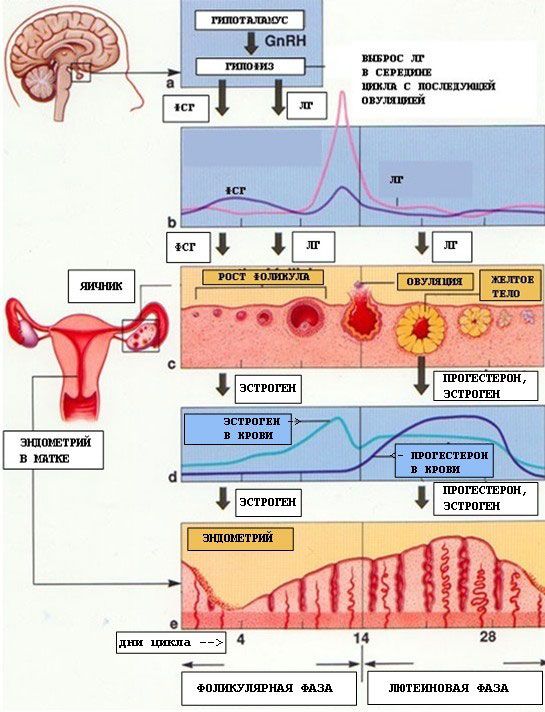Medical expert of the article
New publications
Monthly cyclical changes in a woman's reproductive system
Last reviewed: 04.07.2025

All iLive content is medically reviewed or fact checked to ensure as much factual accuracy as possible.
We have strict sourcing guidelines and only link to reputable media sites, academic research institutions and, whenever possible, medically peer reviewed studies. Note that the numbers in parentheses ([1], [2], etc.) are clickable links to these studies.
If you feel that any of our content is inaccurate, out-of-date, or otherwise questionable, please select it and press Ctrl + Enter.

Throughout the reproductive years, a woman's body undergoes a series of recurring changes each month that prepare her to conceive and carry a child. This regular sequence of changes is called the menstrual cycle, culminating in the flow of menstrual blood from the vagina. All of the eggs produced by the fetus are stored in the ovaries until puberty, when hormones from the anterior pituitary gland (follicle-stimulating hormone and luteinizing hormone) begin a cycle of changes that cause the eggs to mature and be released from the ovary each month. At the same time, the entire reproductive tract system undergoes cyclical changes to prepare it for implantation of the fertilized egg and to nourish the developing embryo. In the days leading up to menstruation, a woman experiences mood changes (e.g., irritability, hypochondria, aggression), feelings of bloating, an increase in abdominal size, and swelling of the breasts.
The menstrual stage lasts 3-5 days. It is bleeding caused by the destruction of the vascular-rich mucous membrane of the uterine body.
The follicular stage lasts until the middle of the menstrual cycle (14 days on average). One of the follicles begins to outpace the others in its development, while the others undergo regression. The follicle gradually produces more and more estrogens, which have a variety of effects on both the entire female body and the reproductive organs: the endometrium thickens, as glands grow in it; the mucus in the cervix becomes more alkaline and decreases. This helps the sperm move along the woman's reproductive tract and maintain their viability.

The ovulatory stage is characterized by a significant increase in estrogen production, and the secretion of luteinizing hormone by the anterior pituitary gland increases sharply, which leads to rupture of the follicle, the release of the egg and its exit into the peritoneal cavity.
The corpus luteum phase (secretory) is characterized by the proliferation of cells of the ruptured follicle, resulting in the formation of a corpus luteum, the cells of which produce the steroid hormone progesterone and estrogens: in the endometrium, further proliferation of glands and blood vessels occurs; the cells secrete a fluid containing amino acids, carbohydrates and mucus.
Taking your temperature at the same time every day is one way to determine when you are ovulating. Some women use this to either increase or decrease their chances of getting pregnant.
Thus, it should be noted that the hormone progesterone (the pregnancy hormone) ultimately reduces the excitability and contractile activity of the uterus, promotes the preparation of the mammary glands for milk secretion, peristalsis of the fallopian tubes and the transport of the egg to the uterus. That is, the egg released from the ovary moves along the fallopian tube, provided that it is passable. At the same time, it is here that, if sperm is ejaculated into the vagina, the egg meets those few (less than 100) of the millions of spermatozoa. And, as a rule, only one of them penetrates the cell membrane into the egg, that is, its fertilization occurs, implantation in the endometrium of the uterus with the formation of the fetus and placenta. Taking into account that ejaculation occurs only at the moment of orgasm, the stage of sexual arousal of a man and a woman deserves special consideration.
Menstrual related problems
Dysmenorrhea is a menstrual dysfunction characterized by fairly severe spasmodic pain. It is more common in girls. It usually becomes less pronounced after a woman gives birth. It may be accompanied by nausea, vomiting, diarrhea, and irritability.
Strong and prolonged muscular contractions of the uterine wall can be caused by:
- increased concentration of prostaglandins in the uterus and its cervix;
- dilation of the cervix due to the passage of blood clots;
- pelvic infection;
- endometriosis - a condition in which endometrial tissue develops in the pelvic cavity outside the uterus (appears after age 20);
- adenomyosis - a condition in which endometrial tissue is implanted into the wall of the uterus; the use of intrauterine contraceptives;
- benign tumors of the uterus.
Heat helps relieve pain: you can apply a hot water bottle to your stomach or back. Physical exercise during menstruation can relieve pain because it promotes the release of endorphins in the brain, which are natural painkillers. The lower abdomen can be lightly lubricated with ichthyol ointment mixed with Vaseline. In the evening, drink a cup of hot ginger decoction with sugar. The decoction should be very strong. Drink it all the days while your period lasts.
You can take oregano tincture 30-40 drops 3-4 times a day (10 g of herb per 150 ml of 70% ethyl alcohol - leave for 7-10 days in a dark place at room temperature) or oregano infusion (2 tablespoons per 2 cups of boiling water) 20-40 minutes before meals.
In accordance with the doctor's recommendations, antispasmodic and analgesic drugs are used: noshpa, baralgin, spazmalgon, donalgin, analgin, in extreme cases tramadol; as well as non-steroidal anti-inflammatory drugs: aspirin, ibuprofen, naproxen, nimesulide, indomethacin, diclofenac, etc. (reduce the level of prostaglandins in the body). Sedatives are almost always added.
A favorable effect has been noted from taking the oral hormonal contraceptive marvelon for 4-6 cycles. Three-phase hormonal contraceptives triregol, danoldanazole are also used, starting from the first day of menstruation for 4-6 cycles daily until a positive effect is achieved. These drugs are not prescribed to patients with diabetes, heart and kidney failure, epilepsy. Hormonal drugs are not recommended for teenagers and girls.
In severe cases, hormones (lupron or danazol) are prescribed.
In most European countries there are drugs containing antiprostaglandin.
Premenstrual syndrome
Premenstrual syndrome (PMS; premenstrual tension) is a complex of pathological symptoms that occurs before menstruation (7-14 days) and stops at the onset or during the first days of menstruation. Premenstrual syndrome can be observed both during puberty and during other transitional periods in a woman's life (after childbirth, especially complicated ones, during menopause, menopause, after gynecological operations).
The causes of premenstrual syndrome are not fully understood, but may be due to fluctuations in hormone levels (especially estrogen and progesterone). Another factor may be elevated levels of prostaglandin in the blood.
The main causes of premenstrual syndrome:
- increased stress levels;
- overwork;
- caffeine, high fluid intake, and smoking (may increase symptoms);
- depression;
- Vitamin B6 deficiency.
In most cases, premenstrual syndrome manifests itself simply as irritation, bad mood, or tearfulness.
Common symptoms of premenstrual syndrome include:
- headache;
- dizziness or fainting;
- sudden mood swings;
- scattered attention;
- increased or decreased sexual desire;
- soreness and engorgement of the mammary glands;
- acne outbreaks;
- bloating, constipation, diarrhea;
- joint pain;
- fluid retention, causing weight gain and swelling of the face, ankles, and hands;
- awkwardness in movements and a tendency to injury;
- insomnia.
On the recommendation of a doctor, non-steroidal anti-inflammatory drugs (indomethacin, ibuprofen, aspirin, nimesulide), diuretics, vitamins B6, E, magnesium; sedatives, antidepressants, tranquilizers; contraceptives (marvelon), hormones (danazol, lupron) are used.


 [
[